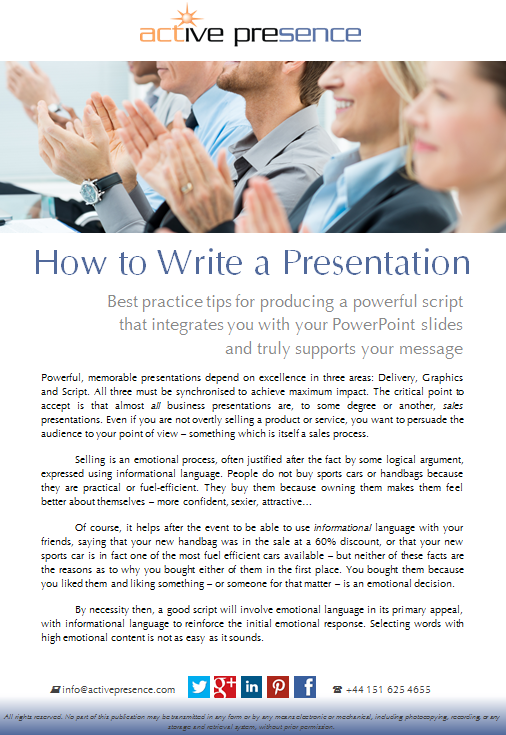How to Write a Presentation
Best practice tips for producing a powerful script that integrates you with your PowerPoint slides and truly supports your message
Powerful, memorable presentations depend on excellence in three areas: Delivery, Graphics and Script. All three must be synchronised to achieve maximum impact. The critical point to accept is that almost all business presentations are, to some degree or another, sales presentations. Even if you are not overtly selling a product or service, you want to persuade the audience to your point of view – something which is itself a sales process.
Selling is an emotional process, often justified after the fact by some logical argument, expressed using informational language. People do not buy sports cars or handbags because they are practical or fuel-efficient. They buy them because owning them makes them feel better about themselves – more confident, sexier, attractive…
Of course, it helps after the event to be able to use informational language with your friends, saying that your new handbag was in the sale at a 60% discount, or that your new sports car is in fact one of the most fuel efficient cars available – but neither of these facts are the reasons as to why you bought either of them in the first place. You bought them because you liked them and liking something – or someone for that matter – is an emotional decision.
By necessity then, a good script will involve emotional language in its primary appeal, with informational language to reinforce the initial emotional response. Selecting words with high emotional content is not as easy as it sounds.
How to write a presentation (the key considerations):
Authenticity: the words you choose have to be authentic to you. They have to be words that you would use off-stage, in real life. Everything you say on-stage should resonate strongly with how you would express yourself off-stage.
Audience appeal: your script should also resonate with your audience’s emotional state. I'm sure everybody reading this flyer can recall at least one speech they have sat through in which the speaker and the audience were simply not ‘on the same page’ emotionally. Typical examples include inappropriate (and often poorly performed humour) in the boss’s Christmas party speech, or the Best Man's speech at a wedding ceremony.
Local application: emotional language is often idiomatic, which is what makes it so exciting and direct. However, it provides obvious challenges for international speakers and audiences. While the term, “…gut wrenching…” may feel exactly right to you, will the non-native English speakers get the message? For the very reason that emotional language packs such a punch, it's important to make sure the words you use fit within the emotional envelope of your audience. Push them too far and they'll just switch off.
There are other ways in which you can enhance your presentation in such a way that it grips the audience immediately and quickly. Starting a sentence with the word ‘and’ is a good example. On hearing the word ‘and…’, some audience members will instinctively feel it was being used as a conjunction and think they have missed the first part of the sentence – the result being that they quickly settle down and pay attention:
“And so ladies and gentlemen there I was…” is a great way to start – straight into the action and very gripping.
The rest of your script should use words that lead listeners to the conclusion that things are going to happen, or life is exciting, or progress will occur. The clearer you are, the more believable you are. People crave leadership, demonstrate it and you can’t help but deliver a powerful, memorable performance.

